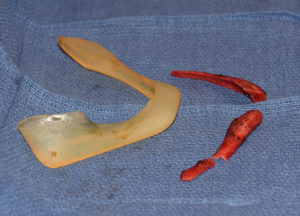There are two basic biomaterials used today in facial implants. Solid silicone is the most commonly used as it is easier to manufacture, is available in the most diverse number of implant styles and sizes and can be more easily inserted through smaller incisions. Medpor or porous polyethylene is the other material and its one and only advantage is that it allows issue ingrowth onto the surface of the material.
That material advantage for Medpor, however, often turns out to be a disadvantage when revision or removal is needed. (and this is not a rare need amongst facial implants in general) The tissue ingrowth makes them very adherent in the pocket and, compared to silicone facial implants, is so much more difficult to remove that some surgeons say that it is impossible. (or will not even make an attempt to do so)

Some interesting observations about Medpor removals is that the easiest side to elevate is the section of the implant against the bone as it does not get any bone growth into it. (as is often touted that it does) Bone settling (often erroneously called bone erosion) occurs just as commonly in Medpor implants as silicone. The most stuck side is the part of the implant that is against the overlying soft tissue and is best separated through the use of needlepoint electrocautery. What often makes these implants harder to remove than they otherwise would be is the excessive number of screws that are often placed to fixate them.
Dr. Barry Eppley
Indianapolis, Indiana


